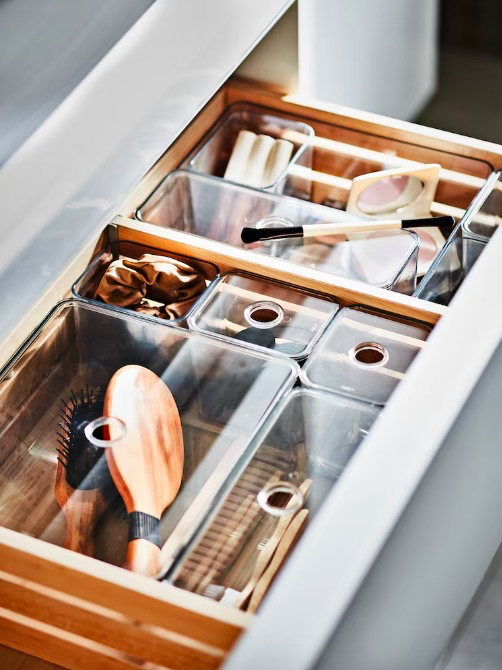How to organize every cabinet in your apartment, with a little help from the pros
No more jump scares when you open them


We are sick of hearing ourselves say it, and should probably start practicing what we preach, but if you have limited square footage in your apartment, being organized is the only way to make the most of that tiny space. And we mean really organized — right down to that dreaded space under the sink where bleach and disinfectant wipes go to die. Every nook of every cabinet available to you needs to be clutter-free and working hard, especially when you're living in a small space.
Might sound a little overwhelming but we have asked the experts for a plan of action that will make it feel more manageable, and we promise the efforts will be worth it. Once you are one of those smug people that have their bathroom cabinet organized by usage, or their spices stored alphabetically, or pots and pans stacked so efficiently you won't continue to use the most conveniently placed item (even if it's not right for the job), you'll see...
How to organize any cabinet in your home
Before we get into the nitty gritty and take this room by room, ahead of organizing any cabinet decide on its functionality.
"Firstly it is important to decide on their use and then, more importantly, stick to that decision which will help to keep them tidy," says Marcella Caricasole of Think Tidy. "For example, bathroom cabinets can have different uses depending on their size and location: I have organized a few with toiletries, medicines, and clean towels in them and others with just makeup and beauty products. Their use will determine how they get organized." Caricasole has a few pointers for doing this to any cabinet:
- Empty their content on a surface. It will be instantly clear what belongs where. We often use cabinets as temporary "tidy/hiding" places because we are in a hurry or we don't know where things go.
- Set aside anything that doesn't belong.
- Divide their contents into categories.
- Design a layout prioritizing what is used most and what is the least. This will help us with deciding what needs to be placed in the front of the "easy to reach" shelf and what can go in the back of the highest shelf.
- Declutter anything that is old, broken, out of date, not used, not loved, or doesn't fit.
- Make a list of accessories that might help to maximize the space. Boxes, small clear trays, a lazy Susan, containers, etc.
- Search the house for any storage accessories that might fit the list before working out a budget for the purchase of new ones.
- Organize following the layout designed in point four.
How to organize kitchen cabinets

1. Clear everything out and categorize
Yep, it needs to be done. Everything has to come out. Now if you haven't put aside an afternoon to tackle your kitchen cabinets, don't worry. Just take it cabinet by cabinet when you find a spare half an hour or so. What you really want to avoid doing is getting everything out and then running out of time (or motivation) to organize everything back into their homes.
Whether you are doing just one cabinet or the whole kitchen, take a look at what's now left to find space for and organize it into categories. It makes the most sense to do this by type at this stage — for example, mugs, plates, pans, types of dried foods, etc. Make piles of your categories to organize back into your cabinets.
2. Organize by usage
This will probably apply to any cabinet in your apartment, but in a kitchen especially, organizing based on how much you use something makes life so much easier.
Get small space home decor ideas, celeb inspiration, DIY tips and more, straight to your inbox!
Once you have your general categories, it makes sense to organize by the amount you use things, too. You have your mug cabinet, but within that space, you should place your most used mugs front and center. The lesser-used cups can head to the back.
"First make sure you're only keeping what you absolutely need, want, and use," advises Jamie Hord, founder of Horderly Professional Organizing. "Once you know what you want to keep, determine what you're using more often and what you're using seldomly. Place the items you're using most often in prime real estate and the items you're not using as often can live up high or in the back."
3. Consider where you need items to be
"For kitchen cabinets store things near where you use them as much as possible," suggests Diane N. Quintana, founder of Release Repurpose Reorganize. "For instance, pot holders in a drawer near the oven. Cutlery in a drawer near the dishwasher. Keep the dishes you use most often at an easy-to-reach height. Store the things that are seldom used at the back of the cabinet or on an upper shelf."
And as a general rule, we'd say store your bulkier and lesser used items in your lower cabinets and the things you reach for more in the upper cabinets. The upper cabinets should be home to dried foods, glasses, mugs, and dishes. Whereas lower cabinets should store any appliances you don't need on your countertops, pots, and pans, any larger mixing bowls, or serving dishes.
4. Decant dried goods to maximize storage
A well-organized food cabinet can save so much waste. You'll be aware of what you have in your cabinets and when they go out of date, and you'll stop adding to your never-ending collection of chickpeas every time you go to the store. And you'll start using some of those long-forgotten spices you bought on vacation based on a vision of you cooking more exciting dishes once you got home (don't worry we all do it).
"You can always decant dried foods like pastas, grains, baking ingredients, and spices. Keep in mind that this does take some time and maintenance but it can streamline your kitchen and keep food lasting longer," says Hord. "We don't recommend this method for everyone and if this doesn't work for you, think more 'big picture' and organize each category in a basket like all pasta in 1 basket, and be sure to label!"
Hord also notes that it's smart to organize your cooking goods in a way similar to a grocery store. "Put baking supplies together, oils, vinegars, and condiments together etc.," she says. To prevent forgetting what you have Quintana says that older canned goods should go in the front and newer in the back. "Get shelf risers or pull-out shelves so you can easily see and access all your foods," she adds.
5. Store your bulky items efficiently
Organizing pots and pans can be a nightmare. But stacking is where we are all going wrong. Stop piling all your pans on top of one another and try organizing them vertically so you don't have to drag a pan from the depths of a pan tower.
"Our favorite organizing product to store pans is this YouCopia Cookware Rack," notes Hord. "It keeps your pans standing up vertically so that you don't have to lift anything to get to what you want and everything is right on hand, making cooking that much easier!"
Quintana says investing in some dividers is another good idea. But even without them, you have options. "If you do not, try stacking pans with paper towels between them," she says. "Try not to keep more pots and pans than you actually use. Also, keep lids on the pots if possible or store them vertically on the inside of the cabinet door."
How to organize bathroom cabinets

1. Have a ruthless cull
We are equally guilty of collecting too many skincare and makeup products, and an organized bathroom cabinet makes it really easy to hold on to things we have either tested and don't like or have simply forgotten about and replaced with something new.
Take everything out and remind yourself of what's in there. Do you still use it? Is it expired? "Same thing with any space, first determine what is keep, toss, or donate," says Hord. "Be sure to check expiration dates or know when something is old. Open, used products can create bacteria over time. It's best to use up one product at a time before moving on to the next to avoid half-used bottles that end up getting lost and old."
Quintana agrees that staying on top of products' shelf life is important and if they're actually working for you. "Go through them regularly and remove the things you don't like, Sometimes the ads for things make us want to try them," she says. "We try it once, never use it again, and it lingers clogging the space in our bathroom. Just say goodbye to those products." Amen.
2. Sort by frequency of use
Like with your kitchen cabinets, organize your bathroom cabinets based on how much you use a product. Your daily cleanser, for example? You need to be able to grab that with your eyes closed. Wax strips? Well, they can probably be hidden at the back...
"Store your go-to daily items in an area that's easy to get to, like the medicine cabinet or top drawer, and store any 'backstock' below or in a closet nearby to refill when needed," says Hord. "We love using stackable drawers under sinks, acrylic single drawer dividers in medicine cabinets, and these like-it bricks in drawers."
3. Use smaller storage solutions to categorize products
Sometimes your storage spaces become black holes and you lose sight of what you actually have. "Bathroom cabinets can be empty caverns where products and accessories get lost," says Quintana. "Measure the space and then find either stacking drawers or shelves to make use of the vertical space and the depth. You can hang the hair dryer on the cabinet door and use the space in the cabinet for the products. For bathroom cabinets that are narrow, consider corralling small products in bins so things don't fall out when you open the door."
4. Have regular declutters
Add keep on top of it! Don't go through all the effort of organizing your bathroom cabinet just to have it explode again the next time you get ready in a rush or the next time you get carried away buying new products.
Every month or so just go through your cabinet and check all the expiration dates and make sure that you're still using it often enough to warrant keeping it. And do the same when you buy new products, too. Rather than just shoving old things to the back, use it up before you open the shiny new bottle.
How to organize your cleaning supplies cabinet
Whether this lives in the bathroom or the kitchen, a cleaning closet or cabinet can be a super quick place to get organized in a matter of minutes. Just take the tips from above and start organizing by category, then use smaller storage containers to corral your products.
"Cleaning products can be organized under the sink, in a closet, in a cabinet or even behind the door," says Hord. "Use containment to create structure and to categorize the cleaning products like 'floor,' 'bathroom,' or 'multi-surface cleaners.' Using organizing products that are easy to clean in case there are any spills are a good option to sort and organize these items."
And we know that cleaning products can be just as enticing to buy as skincare, but don't go overboard. It's bad for the planet and bad for clutter. "Keep the bare minimum of cleaning supplies," suggests Quintana. "White vinegar and lemon juice are great cleaning agents. Store cleaning supplies in a caddy that you can carry from place to place around your home. Invest in one that fits inside the cleaning supply cabinet easily and is large enough to store the things you use regularly. Store the things you only use occasionally behind the cleaning caddy or on an upper shelf."
How to organize entryway cabinets
If you have cabinets in your entryway, chances are they are for shoes and accessories. Our top tip for keeping an entryway organized is don't fill cabinets or closets to the brim. You want to always be aware of what's in there and it to be reserved for your most used items only. If you can afford the space elsewhere in your home, keep shoes you aren't wearing regularly out of the hallway and put them under the bed, in a closet, or in the attic. Switch them around every season.
"The entryway can be a catch-all for anything coming in and out of the house, which can be a wide variety of items," says Jamie. "Use containment to house each of these categories and label so that everyone in the household knows not only where to find something but where to put it back! If you need to get a furniture piece for your entryway, make sure it's functional, meaning it has storage like drawers or a shelf at the bottom to put baskets."
She also notes that adding wall hooks is a must, especially if you have pets or lots of totes and bags you carry around.
How to organize bedroom cabinets

1. Keep your most used items on surfaces
Now we aren't talking closets here. Closet organization is a whole different can of worms. What we are tackling are the smaller cabinets in your bedroom, including drawers and nightstands.
So let's start with the bedside table, or maybe you have drawers next to your bed? Or squeezed in a floating shelf? Either way, the first obvious step is to only keep what you use regularly on the surface. Don't clutter up that valuable real estate with your always-growing pile of books to be read. Keep it simple. Store any jewelry you take off at night in a dish (looks cute and does the job), keep the ONE book you are currently reading on show, have a spot for your phone or alarm clock, and maybe a coaster for a glass of water.
2. Organize drawers based on what you reach for most
A nightstand with drawers can be a real asset when you are trying to squeeze in some extra bedroom storage. But they can also quickly become a dumping ground for random tech, toiletries, and more. So, just as with kitchen and bathroom cabinets, organize your bedside cabinet based on what you reach for most.
If you have multiple drawers, use that top one for your nightly skincare, phone charger, headphones, or whatever you need to grab before you sleep. The lower drawers can be used for things you don't reach for every night, but make sense to be next to your bed, like medication, the book you want to read next, or a facemask you only use weekly.
3. Use smaller organizers to keep drawers tidy
This will make it easier to reach for things and it will make the contents of your drawer look a lot neater. If you have the space for drawer dividers, you can categorize into sections to make it even faster to find what you need. And if you have deep drawers, really utilize that vertical space by using stackable organizers so you can double the amount of storage available.

Hebe joined the Real Homes team in early 2018 as Staff Writer before moving to the Livingetc team in 2021 where she took on a role as Digital Editor. She loves boho and 70's style and is a big fan of Instagram as a source of interiors inspiration. When she isn't writing about interiors, she is renovating her own spaces – be it wallpapering a hallway, painting kitchen cupboards or converting a van.